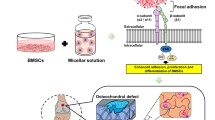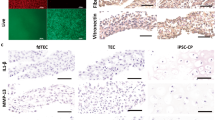Abstract
To repair complexly shaped tissue defects, an injectable cell carrier is desirable to achieve an accurate fit and to minimize surgical intervention. However, the injectable carriers available at present have limitations, and are not used clinically for cartilage regeneration. Here, we report nanofibrous hollow microspheres self-assembled from star-shaped biodegradable polymers as an injectable cell carrier. The nanofibrous hollow microspheres, integrating the extracellular-matrix-mimicking architecture with a highly porous injectable form, were shown to efficiently accommodate cells and enhance cartilage regeneration, compared with control microspheres. The nanofibrous hollow microspheres also supported a significantly larger amount of, and higher-quality, cartilage regeneration than the chondrocytes-alone group in an ectopic implantation model. In a critical-size rabbit osteochondral defect-repair model, the nanofibrous hollow microspheres/chondrocytes group achieved substantially better cartilage repair than the chondrocytes-alone group that simulates the clinically available autologous chondrocyte implantation procedure. These results indicate that the nanofibrous hollow microspheres are an excellent injectable cell carrier for cartilage regeneration.
This is a preview of subscription content, access via your institution
Access options
Subscribe to this journal
Receive 12 print issues and online access
$259.00 per year
only $21.58 per issue
Buy this article
- Purchase on Springer Link
- Instant access to full article PDF
Prices may be subject to local taxes which are calculated during checkout






Similar content being viewed by others
References
Langer, R. & Vacanti, J. P. Tissue engineering. Science 260, 920–926 (1993).
Oberpenning, F., Meng, J., Yoo, J. J. & Atala, A. De novo reconstitution of a functional mammalian urinary bladder by tissue engineering. Nature Biotechnol. 17, 149–155 (1999).
Wang, P., Hu, J. & Ma, P. X. The engineering of patient-specific, anatomically shaped, digits. Biomaterials 30, 2735–2740 (2009).
Chen, V. J., Smith, L. A. & Ma, P. X. Bone regeneration on computer-designed nano-fibrous scaffolds. Biomaterials 27, 3973–3979 (2006).
Elisseeff, J. et al. Transdermal photopolymerization for minimally invasive implantation. Proc. Natl Acad. Sci. USA 96, 3104–3107 (1999).
Kloxin, A. M., Kasko, A. M., Salinas, C. N. & Anseth, K. S. Photodegradable hydrogels for dynamic tuning of physical and chemical properties. Science 324, 59–63 (2009).
Rice, M. A., Waters, K. R. & Anseth, K. S. Ultrasound monitoring of cartilaginous matrix evolution in degradable PEG hydrogels. Acta Biomater. 5, 152–161 (2009).
Wang, D. A. et al. Multifunctional chondroitin sulphate for cartilage tissue–biomaterial integration. Nature Mater. 6, 385–392 (2007).
Benoit, D. S., Schwartz, M. P., Durney, A. R. & Anseth, K. S. Small functional groups for controlled differentiation of hydrogel-encapsulated human mesenchymal stem cells. Nature Mater. 7, 816–823 (2008).
Strehin, I., Nahas, Z., Arora, K., Nguyen, T. & Elisseeff, J. A versatile pH sensitive chondroitin sulphate-PEG tissue adhesive and hydrogel. Biomaterials 31, 2788–2797 (2010).
Esfand, R. & Tomalia, D. A. Poly(amidoamine) (PAMAM) dendrimers: From biomimicry to drug delivery and biomedical applications. Drug Discovery Today 6, 427–436 (2001).
Roberts, J. C., Bhalgat, M. K. & Zera, R. T. Preliminary biological evaluation of polyamidoamine (PAMAM) Starburst(TM) dendrimers. J. Biomed. Mater. Res. 30, 53–65 (1996).
Stevens, M. M. & George, J. H. Exploring and engineering the cell surface interface. Science 310, 1135–1138 (2005).
Meredith, J. E., Fazeli, B. & Schwartz, M. A. The extracellular-matrix as a cell-survival factor. Mol. Biol. Cell 4, 953–961 (1993).
Gullberg, D. & Ekblom, P. Extracellular matrix and its receptors during development. Int. J. Dev. Biol. 39, 845–854 (1995).
Rosso, F., Giordano, A., Barbarisi, M. & Barbarisi, A. From cell–ECM interactions to tissue engineering. J. Cell. Physiol. 199, 174–180 (2004).
Ma, P.X. Biomimetic materials for tissue engineering. Adv. Drug Deliv. Rev. 60, 184–198 (2008).
Liu, X. H. & Ma, P. X. Polymeric scaffolds for bone tissue engineering. Ann. Biomed. Eng. 32, 477–486 (2004).
Woo, K. M., Chen, V. J. & Ma, P. X. Nano-fibrous scaffolding architecture selectively enhances protein adsorption contributing to cell attachment. J. Biomed. Mater. Res. A 67A, 531–537 (2003).
Benya, P. D. & Shaffer, J. D. Dedifferentiated chondrocytes reexpress the differentiated collagen phenotype when cultured in agarose gels. Cell 30, 215–224 (1982).
Hu, J., Feng, K., Liu, X. & Ma, P. X. Chondrogenic and osteogenic differentiations of human bone marrow-derived mesenchymal stem cells on a nanofibrous scaffold with designed pore network. Biomaterials 30, 5061–5067 (2009).
Mitragotri, S. & Lahann, J. Physical approaches to biomaterial design. Nature Mater. 8, 15–23 (2009).
Zhang, Z., McCaffery, J. M., Spencer, R. G. & Francomano, C. A. Growth and integration of neocartilage with native cartilage in vitro. J. Orthop. Res. 23, 433–439 (2005).
Ahsan, T. & Sah, R. L. Biomechanics of integrative cartilage repair. Osteoarthr. Cartil. 7, 29–40 (1999).
Hunziker, E. B. Articular cartilage repair: Basic science and clinical progress. A review of the current status and prospects. Osteoarthr. Cartil. 10, 432–463 (2002).
O’Driscoll, S. W., Keeley, F. W. & Salter, R. B. The chondrogenic potential of free autogenous periosteal grafts for biological resurfacing of major full-thickness defects in joint surfaces under the influence of continuous passive motion. An experimental investigation in the rabbit. J. Bone Joint Surg. Am. 68, 1017–1035 (1986).
Acknowledgements
The authors would like to acknowledge the financial support from the National Institutes of Health (Research Grants DE015384 and DE017689: P.X.M.). The authors would also like to acknowledge the assistance from J. Hu in the animal experiments.
Author information
Authors and Affiliations
Contributions
X.L. and X.J. contributed overall equally to the experimental work. X.L. carried out the polymer synthesis, fabrication of microspheres and structural characterization. X.J. carried out the cell culture, animal studies and tissue analyses. P.X.M. was responsible for the overall project design and manuscript organization. All authors contributed to the scientific planning, data analysis and interpretation.
Corresponding author
Ethics declarations
Competing interests
The authors declare no competing financial interests.
Supplementary information
Rights and permissions
About this article
Cite this article
Liu, X., Jin, X. & Ma, P. Nanofibrous hollow microspheres self-assembled from star-shaped polymers as injectable cell carriers for knee repair. Nature Mater 10, 398–406 (2011). https://doi.org/10.1038/nmat2999
Received:
Accepted:
Published:
Issue Date:
DOI: https://doi.org/10.1038/nmat2999
This article is cited by
-
Recent Advancements on Three-Dimensional Electrospun Nanofiber Scaffolds for Tissue Engineering
Advanced Fiber Materials (2022)
-
Injectable hydrogels for bone and cartilage tissue engineering: a review
Progress in Biomaterials (2022)
-
Engineering of Immune Microenvironment for Enhanced Tissue Remodeling
Tissue Engineering and Regenerative Medicine (2022)
-
Biocompatible in situ-forming glycopolypeptide hydrogels
Science China Technological Sciences (2020)
-
Optimizing material and manufacturing process for PEGDA/CNF aerogel scaffold
Journal of Porous Materials (2020)



